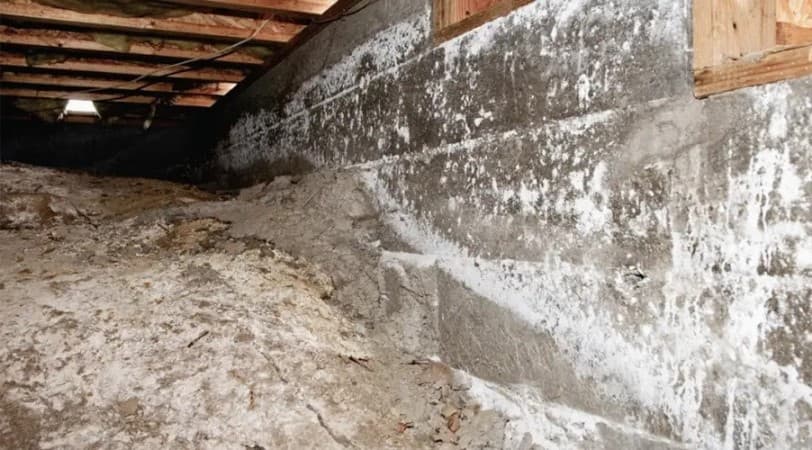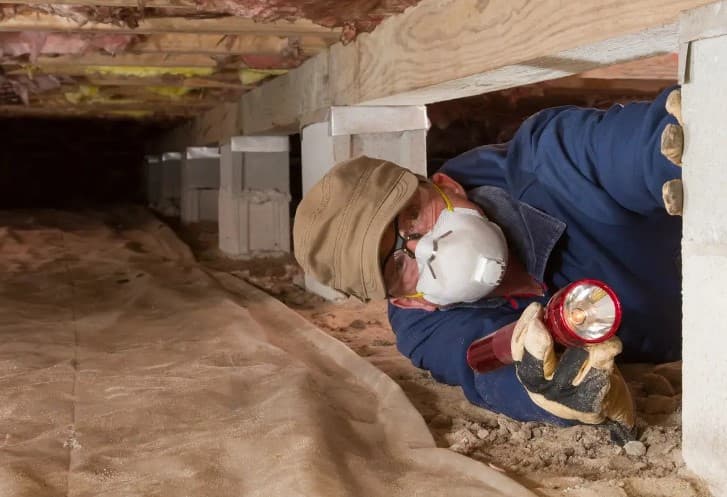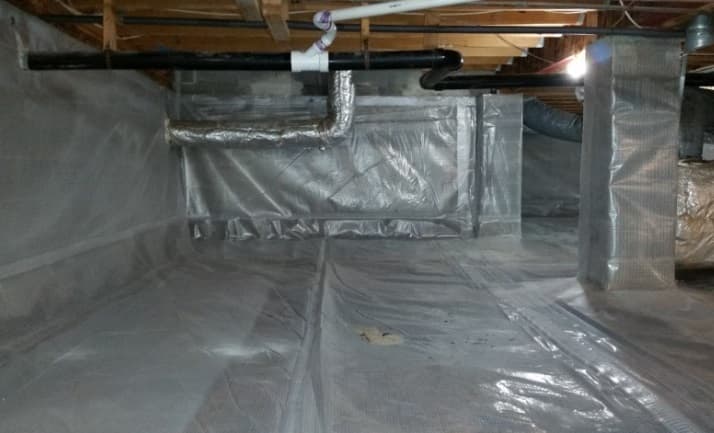Mold in crawl spaces is a serious issue that can lead to structural damage, poor indoor air quality, and health risks. If left untreated, it can spread throughout your home, causing more significant problems and expensive repairs.
Addressing mold in your crawl space promptly is essential not only for maintaining your home’s integrity but also for ensuring a healthy living environment.
This guide will walk you through the steps needed to effectively clean mold from your crawl space and offer tips on how to prevent it from recurring in the future.
Why Mold Develops in Crawl Spaces?
Crawl spaces are particularly vulnerable to mold growth due to their damp, dark, and often poorly ventilated nature. High levels of humidity, leaks, and lack of air circulation contribute to the perfect environment for mold to thrive. Here are the key factors that contribute to mold growth in crawl spaces:
Moisture and Humidity
Crawl spaces are often prone to excess moisture, which can come from several sources:
- Groundwater Seepage: If your crawl space isn’t properly sealed, groundwater can seep in, raising humidity levels.
- Condensation: Differences in temperature between the air inside the crawl space and the soil or foundation can cause condensation to form on surfaces.
- Plumbing Leaks: Leaking pipes or poor drainage systems can introduce water into the crawl space.
- Poor drainage: Water from rain or snow may not be properly diverted away from the home’s foundation, leading to water pooling under the house.
Mold requires moisture to grow, and in a damp crawl space, there is an abundance of it.
Read More: 10 types of mold that grow in the home
Lack of Ventilation
Crawl spaces are typically poorly ventilated, allowing moisture to build up. Without airflow to dry out the space, humidity levels rise, creating an ideal environment for mold.
Traditional crawl space designs often rely on passive ventilation through small vents, which may not provide enough air circulation to keep the area dry.
Organic Materials
Mold feeds on organic matter like wood, drywall, insulation, or dust. Crawl spaces are often built with wooden floor joists and other organic materials, providing a food source for mold spores.
As moisture seeps in, these materials become damp and more susceptible to mold colonization.
Temperature Fluctuations
Crawl spaces tend to have significant temperature fluctuations, especially in climates with hot summers and cold winters. These changes can contribute to condensation, particularly in uninsulated crawl spaces, which again leads to moisture buildup — one of the key conditions for mold growth.
Inadequate Vapor Barriers
A vapor barrier is a protective layer (usually plastic sheeting) placed on the ground in the crawl space to block moisture from entering the air.
Inadequate or improperly installed vapor barriers can allow moisture from the soil to rise into the air, further increasing humidity levels and promoting mold growth.
Flooding or Storm Damage
During heavy rains or floods, water can collect in the crawl space, leaving it damp for extended periods. If the area isn’t properly dried out, mold can develop within days. Storm damage to the foundation or roof can also contribute to water infiltration in the crawl space.
Signs of Mold in Your Crawl Space
Before beginning the cleaning process, it’s essential to confirm that you’re dealing with mold. Some common signs of mold in crawl spaces include:
Musty Odors
A strong, musty odor is one of the most noticeable signs of mold in a crawl space. Mold releases microbial volatile organic compounds (mVOCs), which give off an earthy, unpleasant smell. This odor often makes its way into the home’s living areas, particularly near floors, vents, or basements.
Visible Mold Growth
If you inspect your crawl space and notice patches of black, green, white, or gray growth on surfaces like wooden beams, insulation, or concrete walls, it’s likely mold.
Mold often appears as fuzzy or slimy spots and can grow in clusters. Be aware that mold might not always be in plain sight, and it may hide in corners or behind insulation.
Health Symptoms in Occupants
Mold can trigger a variety of health symptoms in individuals living in the house. If you or your family members experience unexplained symptoms such as:
- Chronic coughing or sneezing
- Eye, throat, or skin irritation
- Worsened asthma or allergy symptoms
- Frequent headaches or respiratory issues
These symptoms may be caused by mold spores circulating in the air, which can originate from the crawl space. Even if the mold isn’t visible, its presence in the air can lead to these health issues.
How to Safely Clean Mold in a Crawl Space?
Cleaning mold from a crawl space is a challenging but manageable task if done carefully. It’s crucial to take the necessary precautions to avoid exposure to mold spores and prevent further contamination. Here’s a step-by-step guide on how to remove mold effectively.
Step 1: Safety First – Gather Protective Gear
Before entering the crawl space to tackle the mold, you must ensure that you have the proper personal protective equipment (PPE). Mold exposure can cause respiratory problems, skin irritation, and other health issues, so it’s essential to protect yourself.
Essential Protective Gear:
- N95 respirator mask or a full-face respirator to avoid inhaling spores.
- Gloves (rubber or nitrile) to protect your hands from mold and cleaning solutions.
- Protective eyewear such as safety goggles.
- Disposable coveralls to prevent contamination on your clothing.
- Boots with good traction, preferably waterproof, to navigate the damp crawl space.
Step 2: Inspect and Identify Mold-Infested Areas
Once you’ve equipped yourself with protective gear, carefully inspect your crawl space to locate the mold-affected areas. Pay close attention to the following spots:
- Wooden beams and joists
- Concrete walls
- HVAC systems
- Insulation material
Mold can appear in various forms, including black, green, and white patches. Identifying the specific areas will help you focus your cleaning efforts and remove all traces of mold.
Step 3: Contain the Mold Spores
Mold spores can easily spread to other areas of your home if not contained properly. To avoid contamination, seal off the crawl space from the rest of the house. You can use plastic sheeting and tape to cover any vents or openings that lead to living areas.
Step 4: Remove Debris and Dry the Crawl Space
Before treating the mold, it’s essential to clear out any debris and dry the space. Here’s how:
- Remove any standing water or wet materials such as insulation.
- Use a dehumidifier to reduce moisture levels and dry out the crawl space.
- If the area is wet due to a leak, ensure the leak is repaired before proceeding.
Step 5: Clean the Mold with Approved Products
Several products are effective at removing mold from surfaces in crawl spaces. Below are some of the most commonly used cleaning solutions:
Commercial Mold Cleaners:
There are many commercial mold cleaners specifically designed to kill mold spores on contact. These products often contain fungicides that prevent mold regrowth.
DIY Cleaning Solutions:
If you prefer a homemade solution, here are a few options:
- White vinegar: Spray undiluted vinegar on the affected area, let it sit for an hour, and then scrub with a brush.
- Baking soda and water: Mix a tablespoon of baking soda with water and apply the solution to the mold. After scrubbing, rinse the area with water.
- Hydrogen peroxide: Use 3% hydrogen peroxide, spray directly on mold, let it sit for 10 minutes, and scrub away.
Be sure to use a scrub brush with stiff bristles to physically remove the mold from the surface. Work in small sections and rinse off the area after cleaning.
Step 6: Disinfect and Prevent Mold Regrowth
After cleaning the mold, it’s essential to disinfect the area to kill any lingering mold spores. Use a disinfectant spray or a mixture of water and bleach (1:10 ratio) to thoroughly disinfect the surfaces.
To prevent future mold growth:
- Install a vapor barrier on the ground to block moisture from seeping up into the crawl space.
- Improve ventilation by installing crawl space vents or a fan.
- Use a dehumidifier to keep humidity levels below 50%.
Step 7: Inspect and Monitor
Once the crawl space has been cleaned and dried, regularly inspect it for any signs of mold returning. Address any leaks or moisture issues immediately to prevent regrowth. You may also want to schedule professional inspections to ensure that the crawl space remains mold-free.
Conclusion
Cleaning mold in your crawl space is essential for maintaining your home’s health and structural integrity. By following the detailed steps above and taking preventive measures, you can ensure that your crawl space remains dry and mold-free.
Keep a close eye on moisture levels and make necessary repairs promptly to prevent future issues.


